WE HAVE
Top Value For You
Sign up for Travelviet VIP membership to enjoy special offers.
Explore the history, culture, people and breathtaking landscape of Vietnam on the Travelviet app
Download the Travelviet app

Binh Dinh - the land of Nau is famous for its captivating beauty, from beautiful landscapes to unique cultural heritage. If you are preparing for the journey to explore this land of martial arts, join 63Stravel to explore the top 23 beautiful tourist destinations in Binh Dinh, making you not want to leave!
Top 23 tourist destinations in Binh Dinh beautiful like paradise
Immediately save the Binh Dinh tourist destinations below to have a wonderful trip in this land!
Vi Rong Cape
Dragon Cape, also known as Vi Rong Cape, is located far from the city. Quy Nhon is about 70 km north and about 20 km east of Phu My district. This place is named after the special shape of the mountain, which looks like a dragon stretching out into the vast ocean.
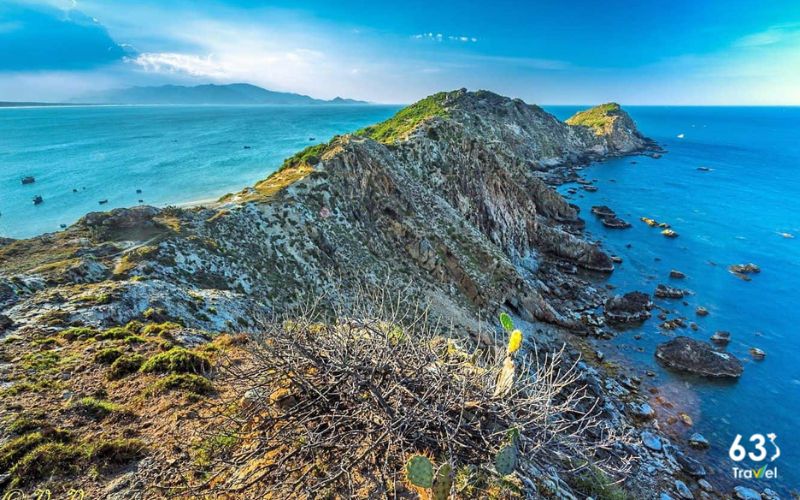
Cape Vi Rong - Magnificent natural masterpiece in the land of Binh Dinh
Coming to Dragon Cape, visitors can not only enjoy the majestic beauty of the sea and sky and interesting rocky outcrops but can also climb mountains, swim in the sea and enjoy the pristine natural atmosphere. In particular, this place is also famous for the "Cau Ngu Festival" which takes place from the 11th to 14th day of the 4th lunar month every year, attracting a large number of tourists with exciting activities such as boat racing, opera singing and cheo mau. at Ong Nam Hai mausoleum. The festival is imbued with the traditional culture of fishermen, praying for a good harvest and good weather.
With its pristine beauty and majestic scenery, Dragon Cape is always the top destination among Binh Dinh tourist destinations. Attracts tourists by the mysterious cave and the unique image of the dragon rock mountain reaching out to the sea, creating a unique scene.
Eo Gio
Eo Gio in Nhon Ly commune, Quy Nhon city, is one of the most attractive destinations of Binh Dinh with wild and unique natural beauty. From a distance, Eo Gio looks like a saddle, but when viewed from above, it appears shaped like a funnel, creating a rare landscape.
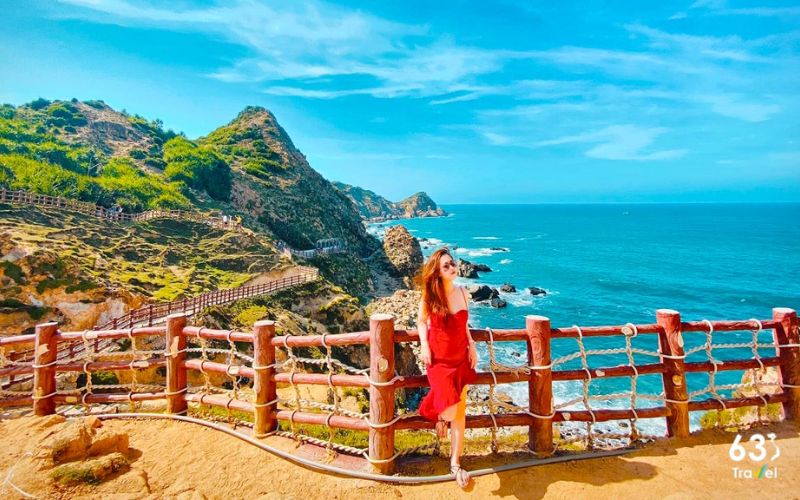
Eo Gio - an ideal check-in point when traveling to Quy Nhon
This place is known as the "place of paradise" thanks to the wonderful combination of mountains and sea. Especially at sunset when the sun gradually disappears behind the horizon, leaving an enchanting atmosphere.
With a clear blue coastline and a beautiful walking path along the mountainside, Eo Gio not only attracts tourists with its majestic landscape but is also an ideal destination for those who love to explore nature. From here, you can easily take a canoe to the famous Ky Co beach, where there is clear sea water, smooth golden sand and uniquely shaped rocks. At Ky Co, visitors can also experience a series of exciting recreational activities such as swimming, kayaking, riding a water motorbike or trying out the banana float game, bringing a feeling of refreshment and excitement.
Dam Thi Nai
Thi Nai Lagoon is the largest in Binh Dinh with an area of more than 5,000 hectares, stretching more than 10 km and nearly 4 km wide, is a charming destination with rich natural beauty. Here, visitors can immerse themselves in the wild scenery, watch the romantic sunset dye the water red and admire flocks of birds flying in the sunset. Don't miss the opportunity to visit Thi Nai Bridge, a famous sea-crossing bridge up to 2,477 m long, an impressive engineering project connecting the mainland with Phuong Mai peninsula.
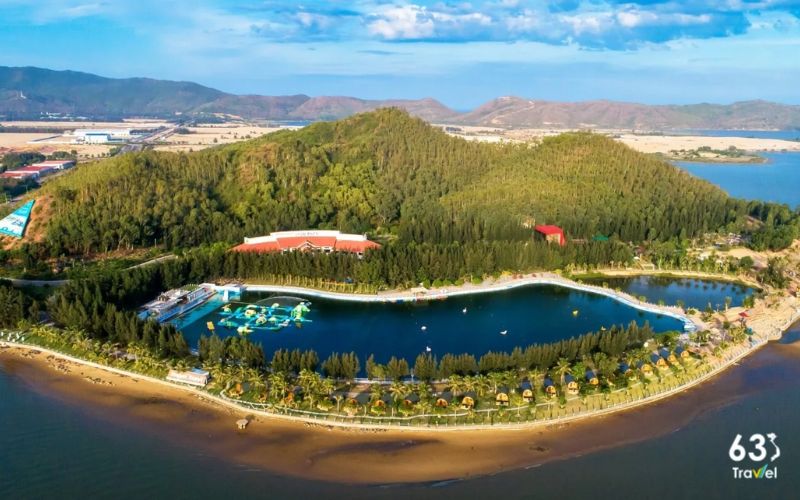
Thi Nai Lagoon - The largest saltwater lagoon in Binh Dinh
Located in the Phuong Mai peninsula area, Dam Thi Nai is not only attractive with its rich mangrove forest system, but also stands out with a small mountain with an ancient appearance, like an ancient tower when viewed from afar. The diverse ecosystem and unique landscape here always captivate visitors, making Thi Nai Lagoon one of the tourist destinations in Binh Dinh that cannot be missed.
Ghenh Rang Tien Sa
Ghenh Rang Tien Sa is located in the southeast of Quy Nhon city, and is a destination not to be missed during your trip to Binh Dinh. Located about 3 km southeast of the city center, this area stands out with unique natural masterpieces such as the majestic lion-shaped rock range, Queen's beach with smooth pebbles and mysterious cave system.
When coming to Ghenh Rang Tien Sa, visitors will not only admire the beautiful moon-shaped seascape, but also have the opportunity to visit the grave of poet Han Mac Tu - a great cultural celebrity of Vietnam. This area includes a complex of adjacent rocky beaches, concentrated along the curve of Xuan Van mountain, spreading over an area of 35 hectares. The amazing beauty and rare landscape of Ghenh Rang Tien Sa has been recognized by the Ministry of Culture and Information as a national monument, affirming the unique cultural and natural value of this place.
Ky Co
Ticket price: 100,000 VND/adult, 50,000 VND/child
Discovering the charming and wild beauty of Ky Co in Quy Nhon will be an unforgettable experience in your journey to explore this beautiful city. Ky Co is considered the "Maldives of Vietnam", outstanding with its majestic but also romantic natural landscape. If you are looking for a place to relax and enjoy the beauty of the sea, come to Ky Co and immerse yourself in the emerald water, or walk on the smooth white sand beaches next to the lush green coconut trees.

Ky Co - Wild beauty in the island paradise of Quy Nhon
With one side facing the sea and the other three sides surrounded by hills and mountains, this place offers a natural setting that is both wild and attractive. In particular, with clear jade water, pristine white sand and blue horizon, Ky Co not only captivates visitors but also helps you forget all your fatigue. The period from March to September is the ideal time to explore Ky Co, when the weather is favorable and the sea is clear blue, bringing you the most wonderful experiences.
Phuong Mai sand dunes
If you are looking for an ideal stop on your journey to explore Quy Nhon, Phuong Mai Sand Dunes is an option not to be missed. This is one of the highest and most impressive sand dunes in the Central region, standing out with its wild and poetic beauty.
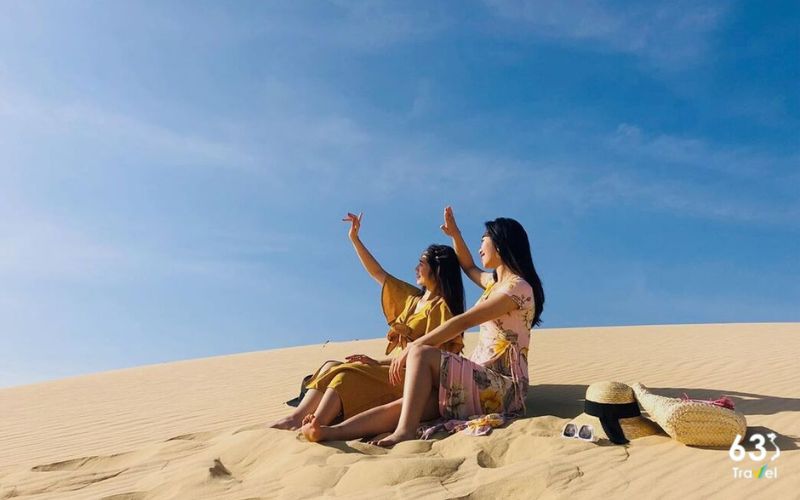
Phuong Mai Sand Dunes - a beautiful, wild and impressive destination
When you come here, you will be immersed in the beautiful natural scenery, conquer the smooth white sand dunes and experience the fun feeling of sandboarding. Don't forget to capture memorable moments with great photos at this unique destination!
>> See more: Collection of beautiful photos of Binh Dinh tourist destinations
Bai Xep
With the title "mysterious pearl," Bai Xep fishing village appears as a great destination for those looking for unique experiences in Quy Nhon. Although it is a small and simple village, Bai Xep is a virtual living paradise with countless beautiful shooting angles for tourists. Here, you will not only be immersed in the ocean space but also have the opportunity to become a real fisherman, or enjoy the romantic sunrise moment.
When mentioning outstanding tourist destinations in Binh Dinh, Bai Xep is always at the top of the list with its beautiful natural landscape. Iridescent golden sand beaches combined with natural rocky outcrops rising in the middle of the water create a perfect picture, making anyone surprised and fascinated at first sight.
Cham towers in Binh Dinh
Ticket price: 15,000 VND/person
Binh Dinh stands out with many Cham tower relic complexes bearing bold historical and cultural imprints. These works are not only architectural masterpieces with exquisite sculptural details but also contain valuable cultural values. When visiting Binh Dinh, you should not miss the opportunity to admire the Banh It tower, twin tower and Duong Long tower complexes to witness firsthand the uniqueness of Champa architecture and save impressive photos.
Banh It Tower was built in the 10th century and stands out with its shape like a traditional banh it, a famous specialty of Binh Dinh. Known for its ancient beauty and perfect combination of art and history, Banh It Tower is always an attractive destination for tourists and those who love to explore cultural heritage.
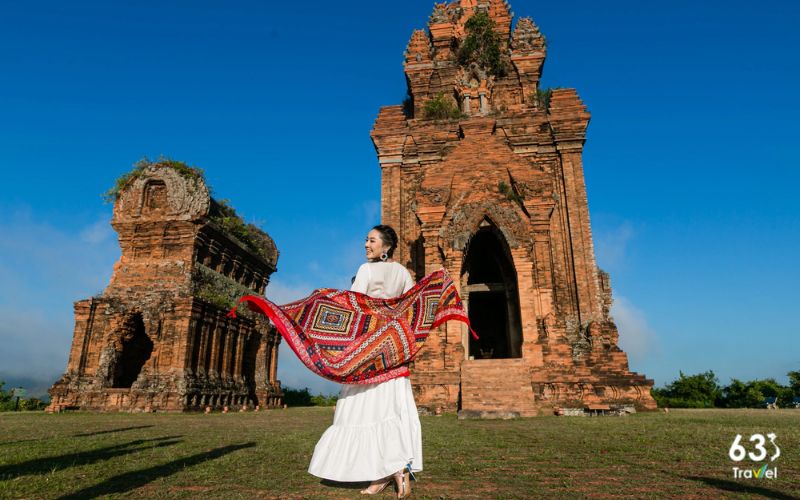
Banh It Tower (Silver Tower)
Twin Towers, also known as Hung Thanh Tower, is one of the ancient Cham relics with great historical value. Built around the end of the 12th century, the period when the Champa empire was most prosperous.
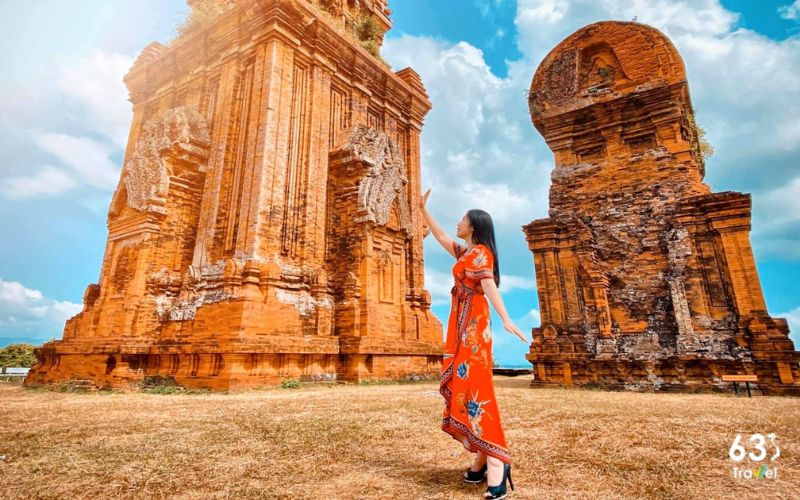
Quy Nhon Twin Towers
The tower cluster consists of two parallel towers, with the large tower about 20 meters high and the smaller tower about 18 meters high. Recognized as a national monument since 1980, the Twin Towers represent a delicate combination of Cham architectural style and the influence of Khmer Angkor Wat art.
Duong Long Tower is located in Tay Son district, is a complex of three soaring towers, built in the late 12th century, the golden age of Champa culture. These three towers are arranged along the North - South axis, with the central tower 39 meters high and the two side towers 32 meters high.
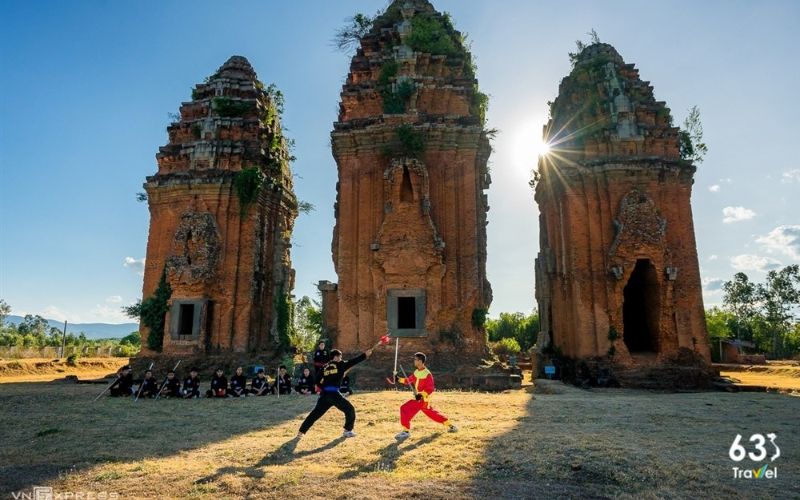
Duong Long Tower, Binh Dinh
Built of bricks and combined with elaborately carved stones, Duong Long Tower is not only attractive by its unique architecture but also by the intricately carved patterns and motifs on the stone. This is an ideal destination for tourists who love mystery and want to explore the ancient beauty of Champa culture.
Quy Nhon Scientific Discovery Center
If you are looking for an attractive destination in Quy Nhon for those who love scientific discovery, the Science Discovery Center is the perfect choice. This place is a diverse and rich combination of spaces, specially designed to attract students and visitors.
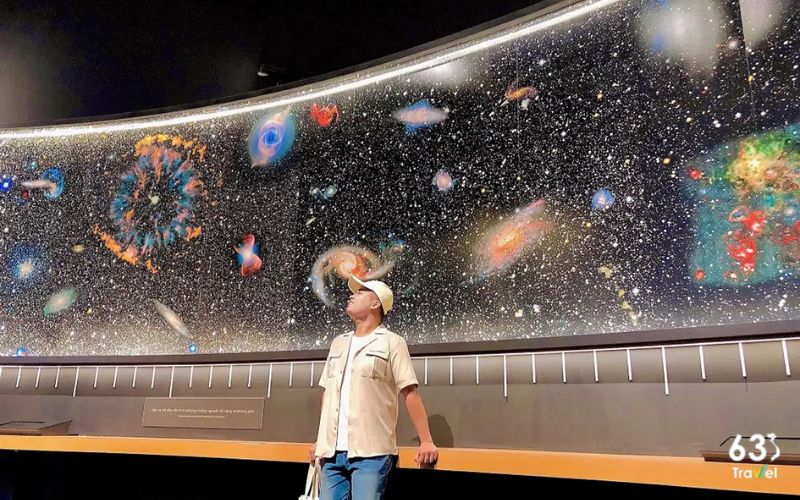
Quy Nhon Science Discovery Center - Where science sublimates
The center offers a variety of discovery rooms and play areas where you can learn about fascinating topics like chemistry, space, and physics through engaging and interactive experiences. An interesting and attractive destination that everyone should visit to explore if they come to this land of Nau!
Nhon Ly fishing village
Nhon Ly fishing village is located on Phuong Mai peninsula, far from the city center. Quy Nhon is about 20km to the Northeast, an ideal destination for those who love simple beauty and quiet space. The village features vibrant frescoes, creating a scene that is both impressive and relaxing.
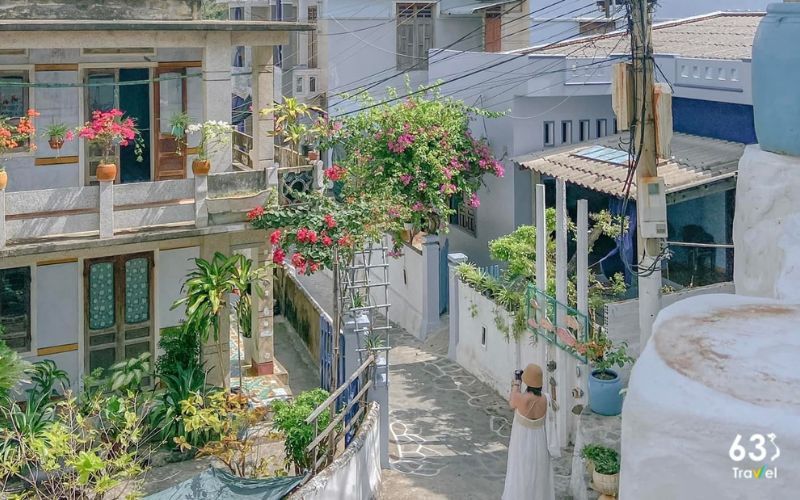
Nhon Ly fishing village - A poetic mural in the middle of Quy Nhon sea and sky
Nhon Ly not only attracts tourists by its simple beauty but also by the preservation of precious Champa cultural relics. Every year, this place holds the Cau Ngu festival with many rich activities, imbued with local cultural identity, promising to bring unique and unforgettable experiences to all visitors.
Bai Rang Quy Nhon
Nestled on the banks of Xuong Ly, along the coastal road connecting Binh Dinh and Phu Yen, Bai Rang Quy Nhon appears as a charming, pristine oasis. Surrounded by two towering mountains shaped like a crescent moon and lush green coconut trees on a pure white sand beach, this place creates a perfect natural picture.
With its rustic and pristine beauty, Bai Rang is a wonderful gift from nature to this land. In addition, this is also a destination that attracts thousands of tourists, both domestic and international, thanks to the delicate combination of landscape and peaceful atmosphere here.
Hon Kho
As one of 32 islands near the shore of Binh Dinh sea, Hon Kho (also known as Hon Kho island) is known as "Maldives of Vietnam" thanks to its wild and romantic beauty. For those who love to explore and look for an ideal "escape" place, Hon Kho is the perfect choice.
When you arrive at Hon Kho, you will be fascinated by the peaceful and unexploited natural scenery. One of the highlights of the island is the 500m long road connecting Hon Kho with Nhon Hai fishing village, which appears when the tide recedes, creating a unique experience. Besides, the wooden bridge along the beach is also a favorite check-in location, allowing you to take beautiful photos.
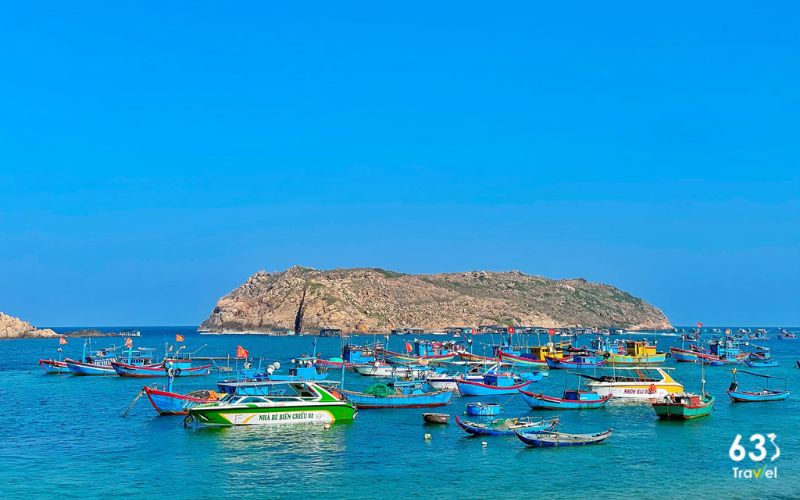
Romance with the wonderful beauty of Hon Kho
At Hon Kho, you can participate in activities such as scuba diving to see coral, swimming, and boating to explore the beauty of the island. Don't forget to enjoy local cuisine at the nearby fishing village, where many delicious dishes are waiting for you.
With its magnificent scenery of rocky mountains and vast sea, Hon Kho has become a destination attracting more and more tourists in recent years. Visitors not only have the opportunity to experience exciting outdoor activities but also admire the natural beauty and explore seaweed fields under clear water.
Bai Dai Quy Nhon
Bai Dai - one of the most attractive beaches when traveling to Binh Dinh, stands out with its wild and idyllic beauty. Although investment in tourism has been invested to meet the increasing needs of tourists, Bai Dai still retains its pristine features, with sharp and bumpy rocks, creating a unique and beautiful landscape. full of charm.
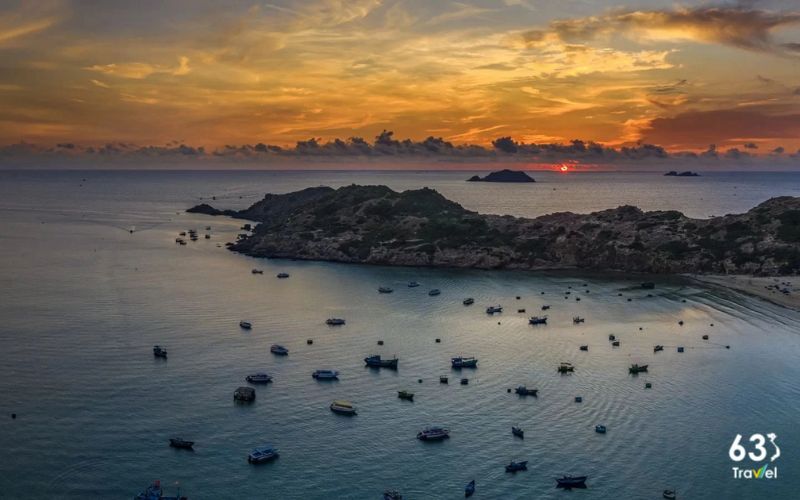
Bai Dai - extremely chill wild camping spot in Quy Nhon
The name Bai Dai was given by local people based on the wild beauty of the beach. The clear blue sea water and whispering waves day and night create a relaxing and peaceful atmosphere. Bai Dai also attracts tourists with interesting experiences such as camping, enjoying fresh seafood and admiring majestic natural scenery. This is not only an ideal place to explore and swim, but also a perfect destination to find peace of mind.
Bai Bang Quy Nhon
Bai Bang is a prominent destination in the list of ideal beaches in Quy Nhon, conquering visitors with its clean and charming beauty. This place not only has a fine white sand beach but is also surrounded by lovely stilt houses, swinging hammocks under cool green trees and rows of coconut trees, creating an ideal relaxing space for visitors. .
With clear blue sea, pristine white sand and brilliant sunshine, Bai Bang is a destination not to be missed to enjoy the fresh sea water and relax after stressful working days. Here, visitors can participate in many interesting activities such as visiting Bai Bang fishing village to discover the lives of hospitable fishermen, climbing mountains, fishing or walking in the woods to admire the sunrise. beautiful.
In the evening, Bai Bang becomes mysterious and romantic with nightfall, the sound of ocean waves lapping on the shore and the lights from fishing boats flashing on the water creating a shimmering, magical scene. . Visitors can set up tents, light a campfire and enjoy local specialties such as chicken, shrimp, king crab and squid, while singing together under the moonlight.
Groups of tourists on the fine sand beach, chatting and playing, make the space even more lively and warm. When the moon rises, the sea becomes even more beautiful, with a wild but gentle beauty that captivates people's hearts and leaves unforgettable moments.
An Son heaven and earth altar
Heaven and Earth Altar (also known as An Son Spiritual Tourism Area) is located on the highest peak of An Son mountain, in Hoa Son village, Binh Tuong commune, Binh Dinh province. This is not only a famous tourist destination but also a proud historical symbol of the three brothers Nguyen Nhac, Nguyen Lu and Nguyen Hue.
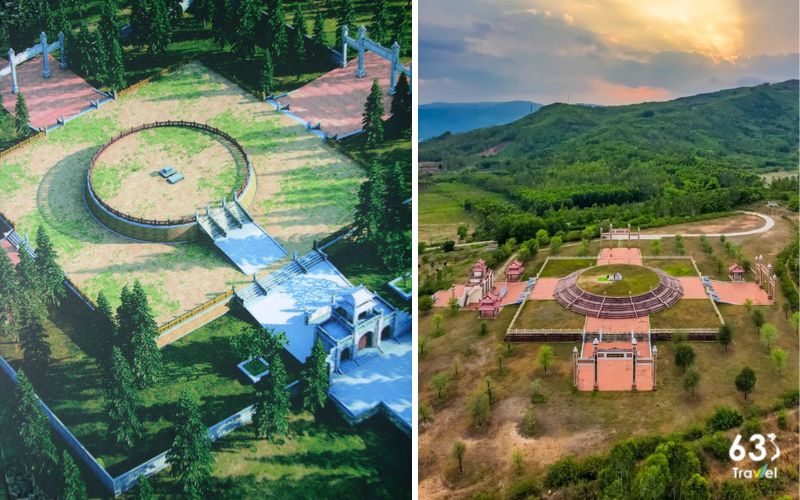
An Son Heaven and Earth Altar - An old relic in Binh Dinh
With a sturdy three-storey structure, the Heaven and Earth Altar stands out not only because of its profound spiritual value but also because of the unique cultural beauty of this land. This place not only attracts tourists by its sacred atmosphere but also by the perfect blend of history and culture, creating a travel experience that is both spiritual and rich in identity.
Quy Hoa Beach
Only 10km from the city center, Quy Hoa Beach is located along National Highway 1D, providing convenience for transportation. This place appears like a wild gem, standing out amidst the hustle and bustle of urban life.
Quy Hoa beach is charming with the perfect combination of blue sky, steady ocean waves and lush green poplars rising in the sunlight. The space here brings a feeling of relaxation, coolness, immersed in the typical flavor of the sea. All create a peaceful paradise, full of life like a separate world completely separate from the noise of the town outside.
>> Read more: Pocket 25+ beautiful tourist attractions in Phu Yen just for you to explore!
Cu Lao Xanh
Cu Lao Xanh is considered a precious gem of Binh Dinh. This place stands out with its wild and poetic natural beauty, along with many attractive destinations such as the over 100-year-old lighthouse, Thanh Nien flagpole and Gieng Tien stream. Visitors to the island not only enjoy the clear blue water but also have the opportunity to participate in exciting experiential activities such as swimming, watching turtles lay eggs, camping, sleeping in tents and night squid fishing with local fishermen. direction.
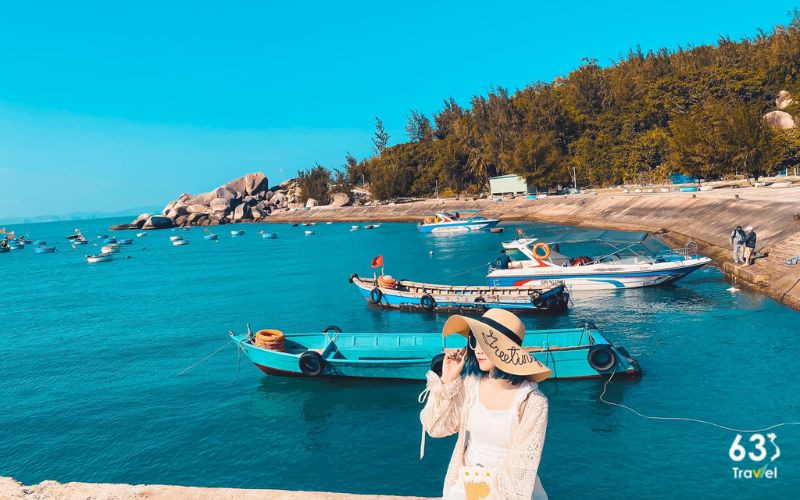
Cu Lao Xanh - Beautiful natural scenery in Quy Nhon
Cu Lao Xanh, with its characteristic blue sea water, is not only attracted by its natural beauty but also by the peace of life here. The island is mainly inhabited by the elderly and children, creating a simple and pristine space ideal for those who love tranquility. The ideal time to explore Cu Lao Xanh is from March to August, when you can organize camping, light a barbecue and have fun dancing on the beach, enjoying memorable moments in the scenery. wonderful nature.
Linh Phong Pagoda
About 30km from Quy Nhon city, Linh Phong Pagoda is a famous spiritual destination that attracts tourists from all over. The pagoda stands out with a 69m high sitting Buddha statue, once the tallest statue in Southeast Asia, placed on a lotus flower halfway up the mountain at an altitude of about 129m above sea level. To admire the giant Buddha statue, visitors must conquer 600 steps, but the reward is the beautiful temple landscape that will make all the effort completely worth it.
Quy Nhon wind turbine field
Quy Nhon wind turbine field has become a destination that attracts a large number of tourists and fans of virtual living. Located next to a beautiful beach and green casuarina forest, the windmill field is the ideal place for you to conquer impressive photos.
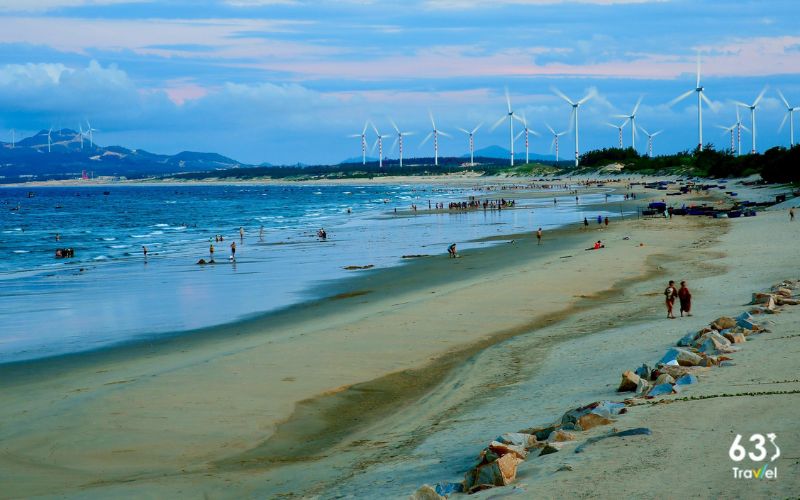
Marvel at the enchanting beauty of Binh Dinh wind power fields
Built in the early years of the 21st century, Quy Nhon wind turbine field not only stands out with its large scale and unique shape but is also a symbol of sustainable development and green tourism of the coastal city. The giant propellers, rising in the vast space, not only create a strong impression but also make an important contribution to the production of renewable electricity and protecting the marine environment.
Not only is it an attractive tourist destination, Quy Nhon windmill field also gives visitors the opportunity to explore the wild and majestic beauty of the sea. Besides, visitors can enjoy the peaceful space of the surrounding fishing village, learn about the unique local history and culture. The wind turbine field, with its blend of modern technology and beautiful nature, brings an exciting and meaningful travel experience.
Ba Nuoc Man Pagoda
About 25km from Quy Nhon city center, Ba Pagoda is located in Phuoc Quang commune, Tuy Phuoc district, Binh Dinh province. The pagoda is also known as Ba Pagoda, outstanding with its Nhat-shaped architecture and located on the Cau Ngoi River. In front of the pagoda is a small lake, with a screen decorated with the image of Long Ma and eight trigrams, representing the Buddhist legend "Long Ma Ha Tu", along with the image of a phoenix bird on the inside.
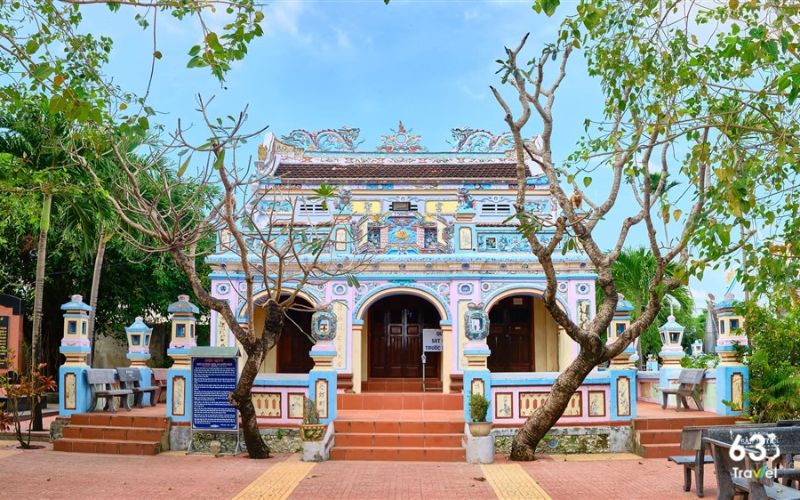
Ba Nuoc Man Pagoda - Unique religious architectural relic in Binh Dinh
Ba Pagoda worships Thien Hau Thanh Mau - a mythical figure who protects ships at sea. This is an ancient architectural work associated with Nuoc Man port, famous from the 16th to 19th centuries. The pagoda's architecture follows the Nam Hoa style, with a boat-shaped curved roof with sophisticated decorative details such as two dragons and moons and porcelain mosaic patterns.
Minh Tinh Pagoda
Although hidden in a small alley, Minh Tinh Pagoda still attracts a large number of people and tourists to pray for good luck and peace, especially during Tet. The main hall of the pagoda stands out with a tall golden tower, a solemn highlight with a majestic meditating Buddha statue in front.
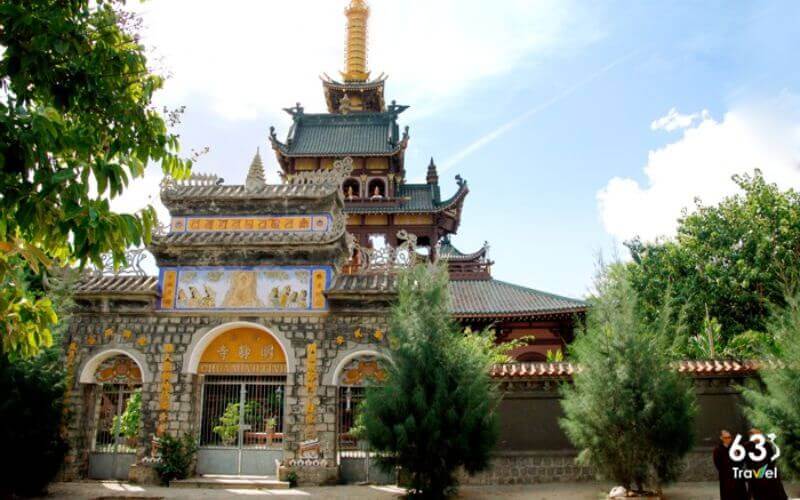
The peaceful beauty of Minh Tinh Pagoda
The temple's architecture is a delicate combination of ancient Eastern culture and modern style, with imitation wood materials and unique reliefs. The space here exudes serenity and peace, giving visitors a feeling of peace and quiet.
Yen Island Binh Dinh
Yen Island is one of the famous tourist destinations in Binh Dinh, attracting many tourists thanks to its magnificent natural landscape and mysterious caves that have existed for millions of years. The dangerous caves hidden deep in the heart of the island create a unique and mysterious beauty, making Yen Island an ideal destination for those who love to explore and adventure, especially in the summer. The combination of pristine natural scenery and impressive geological structures is the irresistible attraction of Yen Island.
Hon Seo
Hon Seo is a small island only about 5km from the mainland, outstanding with its unique wild beauty. Unlike other beaches, this place does not have a long white sand beach, but instead there are large rocks scattered on the sea surface.

Hon Seo - A hidden gem in the sea and sky of Quy Nhon
Although not yet strongly exploited for tourism, Hon Seo still attracts many tourists thanks to its pristine natural beauty and rare tranquility. This is an ideal destination for those who seek peace and want to explore landscapes that have not been affected by tourism development.
Binh Dinh is a majestic martial arts land that not only fascinates tourists with its beautiful natural landscapes and charming beaches, but also offers many attractive entertainment experiences. When you come here, don't miss the opportunity to explore the unique and impressive Binh Dinh tourist destinations that we have introduced in this article. Surely, your trip will be filled with unforgettable memories and interesting discoveries.
Gia Lai 2381 view
Update day : 18/09/2024
Bien Ho Pleiku (Bien Ho T'nung) in Ede language means sea on the mountain. This tourist destination is located in the northwest of Gia Lai province, about 7km from Pleiku city center if following Highway 14. According to local people, this area was once inhabited by a rich and prosperous tribe. Suddenly one day there was a drought, people performed a sacred Giang worshiping ceremony, the sky and earth began to shake, the land around the village collapsed deeply, the water rose to form Pleiku Lake (T'nung Lake). The weather in Pleiku is divided into two distinct seasons: dry season and rainy season. The dry season lasts from November to April of the following year and is also the most ideal time for you to travel to Pleiku Lake (T'nung Lake). March is the coffee flower season, November and December is the season when wild sunflowers begin to bloom. If you travel in the dry season, you can comfortably move and experience the beautiful flower seasons of the Central Highlands' nature. If you want to travel to Pleiku Lake (T'nung Lake) from April to May, you will have the opportunity to participate in special festivals such as the New Rice Celebration. According to the experience of many people, you should limit travel from May to October because this season often has erratic rain and storms, easily making your journey difficult. To visit the dreamy Pleiku Lake (T'nung Lake), you need to start from the city center and run along Highway 14. Then, you turn onto Le Van Sy street and continue going straight to see Signs show the way to Tonle Sap Lake. When you arrive, you can park your car outside the gate and then walk or rent an electric car to go sightseeing. On the way, if you don't know the way or have difficulty, just look up Google Map or ask local people. In addition, you can also get to Pleiku Lake (T'nung Lake) by Pho Duc Chinh street or Le Dai Hanh street. Although this route is longer and has more traffic, it is much easier to travel. Pleiku Lake (T'nung Lake) is famous for its poetic and charming natural scenery. If you are passionate about the blue lake and vast mountains and forests, you must definitely visit this place in your Travel Guide. Pleiku Lake (T'nung Lake) is surrounded by long, green forests and rolling mountains, contributing to creating a very charming space. The entrance to Pleiku Lake (T'nung Lake) is also through a picturesque road. On both sides of the road are large shadows of ancient trees, spreading coolness throughout the path. In particular, at the end of this street there are stone steps leading to the extremely poetic cage house. At this location, you will be able to admire the beautiful scenery, admire the panoramic view of Pleiku Lake (T'nung Lake) and the majestic mountain and forest space. Traveling to Pleiku Lake (T'nung Lake), you will also participate in many exciting fun activities, associated with wild, dreamy mountains and forests. If you love gentleness, you can take a scenic walk by the lake and enjoy the fresh air. Moreover, you can also rent a bicycle to ride around the lake and admire the vast scenery, visiting ethnic villages nearby. In particular, if you are an adventure lover, you can experience rowing around Pleiku Lake (T'nung Lake). During the journey on the lake, you will watch schools of fish swimming around, fishing, and waiting for the sunset to mark the beautiful lake surface. Pleiku Lake (T'nung Lake) is also an ideal dating spot for "virtual living" believers. This place has a pristine landscape like a painting, so when you visit this place, you will have countless beautiful photos to show off to your friends. Some impressive photography backgrounds that you cannot ignore such as green pine roads, panoramic views of the sea and sky... All of them promise to help you capture many memorable moments.
Gia Lai 3553 view
November to April
Only 30km from Pleiku, the waterfall is surrounded by a pristine, mysterious forest ecosystem. Originating from a river on a high mountain top, with a very strong flow creating a majestic landscape. An additional point is the lush primeval forest with rich and diverse flora and fauna, adding to the wild beauty of the tourist area. The 9-storey waterfall does not fall straight down but curves and weaves along the rugged cliffs, dividing the waterfall into 9 levels, which is the reason for the waterfall's name. Each floor has a height of 5 to 10m, with the last 2 floors being about 15m high. With majestic waterfalls, these are the challenges that visitors want to conquer. The waterfall does not fall straight down massively and majestically, but the sound of the waterfall is not small, it still brings majestic beauty, and the winding water creates a magical and poetic feature. From a distance, the waterfall looks like a dragon bending its body, preparing to fly into the sky. Coming here will definitely give you new experiences and perspectives on wild nature. This famous waterfall is located in La Sao commune, about 15km from the center of Ia Grai district, Gia Lai. If you depart from Pleiku city, it only takes about 40 minutes to travel with a distance of about 28km. Gia Lai has a typical tropical monsoon climate divided into two dry seasons (November to April of the following year) and rainy season (May to October). Visitors can come here at any time, each season the waterfall will have a different beauty. However, to make the trip more complete, you should go to the 9-story waterfall in the dry season, when the weather is dry and sunny, favorable for outdoor picnic activities. Avoid going on rainy days, slippery rocks are dangerous. The summer period from May to the end of August is the time when the 9-storey waterfall welcomes the largest number of tourists. This time is sunny and dry, suitable for picnics, taking photos and cooling off intensely with stream bathing activities. After a long journey, you will arrive at the 9-storey waterfall tourist area, where you will become very small in the midst of vast nature, this is the time for you to enjoy the cool space, with the sound of flowing waterfalls. , the sound of birds singing and an extremely cool green space. Especially on summer days, the 9-story waterfall is considered a "giant air conditioner" that helps dispel the heat, giving you a strange feeling of peace and comfort. Along the waterfall, you will enjoy the cool steam of the waterfall as it refreshes your soul. Explore the high waterfall levels, each level will have a deep blue lake with the bottom visible. The waterfall flows with white foam, where the sunlight shines, creating sparkling, magical rainbows. At Gia Lai 9-storey waterfall, tourism has not yet been strongly developed, so there are not too many outstanding eateries or restaurants here. During your trip to the cascading waterfall, prepare food and light drinks to organize BBQ parties next to the waterfall, it will be great. Before going to this famous waterfall in Gia Lai, you should "pocket" some important travel tips to make your trip more complete, including: If you are a tourist in the North, take advantage of booking air tickets and hotels early to enjoy many incentives, discounts and choose the accommodation you like. As a wild tourist destination, you do not need to spend money on entrance tickets to visit. The road to the waterfall is quite easy, but you should control your speed to ensure traffic safety. Food and water are essential for the trip because there are no restaurants around the tourist area at the waterfall. The terrain here is quite slippery, you should prepare anti-slip shoes to ensure safety while moving around the waterfall area. This is a place deep in the forest, so you should bring insect repellent ointment. During the fun, absolutely do not litter the waterfall, collect clean trash to ensure the beauty of the clean and green tourist area.
Gia Lai 3502 view
From May to the end of August
Possessing a height of about 45m, the waterfall flows on a volcanic lava floor and originates from La Peet stream, pouring down in a rushing, white stream. The peaceful stream flowing into the large Ayun river contributes a small part to the Ayun Ha irrigation system with an area of more than 3,700 hectares. Phu Cuong Waterfall is surrounded by vast natural mountains and forests, creating a diverse and impressive ecological system with towering forests, poetic streams and lakes and majestic vertical cliffs. This place promises to bring you exciting experiences when immersing yourself in the mountain and forest space. Phu Cuong Gia Lai waterfall tourist area is open all day, you can freely visit with a ticket price of only 15,000 VND/person. You will have an enjoyable picnic with interesting activities at the resort. Characteristic of the tropical monsoon climate of the Central Highlands, the weather in Gia Lai is divided into two seasons: dry and rainy. Here, we welcome tourists all year round. Each season, the waterfall has a different beauty. majestic, sometimes gentle like a young girl. During the rainy season around May - October, the amount of water flowing down the waterfall is abundant, the waterfall flows strongly with white foam and the water flows fast. Coming here at this time you will see the majestic and magnificent beauty of the waterfall. nature. In the dry season from November to April, the waterfall flows more gently and gently, although not as majestic as the rainy season, instead it will have a more poetic and peaceful beauty. In the sunshine of the red land of the Central Highlands, soaking in the cool water of the waterfall will make travelers from far away feel more soothed and comfortable. According to Phu Cuong waterfall travel experience, you should spend a whole day to explore and conquer this majestic waterfall. Your job is to prepare good health and a comfortable spirit to explore the mountains and forests of the Central Highlands. Because there are not too many outstanding eateries or restaurants near the tourist destination, we advise you when visiting Phu Cuong waterfall to prepare food and drinks for snacks, or organize exciting outdoor parties. guide in the area near the waterfall. It's wonderful to admire the romantic mountain scenery while enjoying delicious food together. Because there are not too many outstanding eateries or restaurants near the tourist destination, we advise you when visiting Phu Cuong waterfall to prepare food and drinks for snacks, or organize exciting outdoor parties. guide in the area near the waterfall. It's wonderful to admire the romantic mountain scenery while enjoying delicious food together. In addition, you need to note that Phu Cuong Waterfall is a strictly managed tourist destination, so if you want to film, take wedding photos or camp overnight, you need to contact in advance for specific and accurate instructions. When playing on the waterfall, absolutely do not litter. You need to maintain general hygiene, be conscious, and travel civilized to preserve the beauty of the tourist area. The waterfall area is quite slippery and dangerous, do not play, run or jump, play safely.
Gia Lai 3340 view
November to April
Thac Ba Lake is located in the heart of Gia Lai, hidden in winding paths. Hidden within the vast green patches of grass and trees is the Thac Ba stream, which is working day and night to bring water to the villagers here. Thac Ba Lake is a gift that the Creator has lovingly bestowed on this land of the Central Highlands. With a water-shaped design, originating from Ia Nueng village (Pleiku City Lake), water flows here to create Thac Ba Lake. Unlike H'Mun Waterfall, which has white water flowing down from above, vertically, like a giant wall, Thac Ba Lake is a crystallization of water streams located on the ground at a height of about 5m. The lake's water flows down to the mouth of a rock cave and the surrounding area. This place was originally a geological fault in ancient times. According to the village elders living here, in the past, in addition to Ba waterfall, there was also Ong waterfall. Both of these waterfalls were strong and majestic at that time. Unfortunately, the erosion of nature over time and human exploitation has left this pair of waterfalls only half as it is today. For some of you who love to explore tourist destinations with wild and rustic beauty, you have only known about Thac Ba Lake in recent years. Because it appeared a long time ago, the scenery here is still preserved, quite complete. Because of that beauty, Thac Ba Lake has been attracting many people to explore, especially young people. Enjoying the fresh air and pristine natural scenery at Thac Ba Lake is one of the interesting experiences you should try once. Referring to Thac Ba Lake, people often evoke a poetic, majestic scene, symbolizing the rustic beauty of the Central Highlands. According to the travel experience of many young people, the most suitable time to move to Gia Lai and explore Thac Ba Lake is in the summer. The dry season in Gia Lai is from March to August. At this time, the water flow is relatively stable. On the contrary, from August to December, Thac Ba Lake often has heavy rain and strong, extremely dangerous water currents. Therefore, you should limit visiting Thac Ba Lake at these times. Thac Ba Lake not only provides a huge water source to help villagers here have a more fulfilling life. Most of the water from the lake will serve irrigation and daily activities for their lives. Not only that, Thac Ba Lake also contributes to improving the air environment, reducing the temperature here by 1 to 2 degrees Celsius compared to normal. The temperature combined with the cool blue water will make the air here always fresh and pleasant. Up to now, Thac Ba Lake is still a famous waterfall in Gia Lai, still retaining the wild features of the Central Highlands. This is a tourist destination that hides interesting things, attracting many young people with passion and desire to explore nature. Therefore, for those who are passionate about learning about the outside world and want to set foot on Thac Ba Lake to discover many interesting things, the road to get here is a small challenge you need to overcome. From the center of Chu Pah district, you move about 8 kilometers along the road to LaLy Hydroelectric Power Plant, then turn left and you will immediately see the waterfall. According to local people, Thac Ba Lake has existed for a long time, but people have only discovered the beauty of the waterfall in recent years. After all that time, Thac Ba Lake is still peaceful hidden behind the endless green forests of this Central Highlands region. Perhaps that is why Thac Ba Lake still retains its somewhat wild, magical and poetic beauty. For those who have visited Thac Ba Lake, this place seems completely different from Princess Waterfall in Gia Lai. Although the nature of Thac Ba Lake is not as aggressive as other waterfalls, somewhere this place still retains a bit of its own aggressiveness. Thac Ba Lake often randomly releases white foam, creating a spreading cool breeze. Stone blocks of all shapes and sizes mark evidence of time. The rays of sunlight shine through, making the waterfall become even more shimmering silver, a thousand times brighter and more sparkling. The trees around the lake are green like an endless carpet of vegetation, small birds are flying in the clear blue sky, singing soft and peaceful melodies. All the sounds and sights here create a wonderful natural picture that holds everyone's footsteps.
Gia Lai 3328 view
From January to December
About 2km from the center of Pleiku city, located on a gentle hill in the heart of a foggy mountain town, Minh Thanh Pagoda appears as a unique architectural complex with magical and ancient beauty that attracts countless tourists. guest. Built in 1964, through many ups and downs of history causing many parts to be damaged, in 1997 the pagoda was restored and built a new one. After a restoration and embellishment process lasting more than 10 years, Minh Thanh Pagoda seems to be wearing a completely new outfit with a unique oriental beauty influenced by Japanese, Chinese, and Taiwanese architecture. . Up to now, the pagoda is not only a place where Buddhists come to worship and worship Buddha, but also attracts many tourists to visit and sightsee. You will be amazed when admiring the majestic and magnificent beauty of the 16m high, 2-storey main hall with a ceiling made of po mu wood, a famous type of wood in the vast forests of the Central Highlands. . Most special is the large pagoda door made of delicately carved wood. Located on both sides of the main hall is the bell tower and Tu An Tower with 3-storey roofs covered with dragon scale tiles and decorated with stylized dragon and lotus motifs. All create a splendid, majestic and elegant scene in the middle of the fanciful smog-covered Pleiku city. Going inside, the main hall space is harmoniously decorated with four thousand-armed, thousand-eyed Lady Buddha statues placed in the four corners, in the middle is the Buddha altar and thousands of statues carved in extremely elaborate relief against the walls. Outstanding among them are 18 Arhat statues made from jackfruit wood and painted with extremely beautiful gilded vermilion. Outside the temple grounds, many miniature landscapes such as lakes and trees are arranged, creating a clear, fresh and harmonious natural landscape amidst the majestic atmosphere of the temple. Not far away is the 9-storey high Xa Loi stupa, meticulously and delicately carved, adorning the beautiful temple space. With majestic beauty in a unique architectural space, Minh Thanh Gia Lai Pagoda is not only a spiritual temple but also a "captivating" beautiful landscape, attracting many tourists to visit. In the majestic space echoing the sound of distant bells, you seem to find peace in your soul at the peaceful Buddha's door.
Gia Lai 3267 view
From January to December
Kon Chu Rang Nature Reserve is a tourist destination located in Son Lang commune, K'Bang district, Gia Lai province. If you look on the map, this area is located between the East and West of the Truong Son range. Along with that, this place has quite rich vegetation and an extremely magnificent and lively natural network. Especially the mountains and the alternating river and stream system help attract tourists to come here for an unforgettable experience. Kon Chu Rang Nature Reserve has a total area of 719 km², of which the area of the reserve is 159,000 hectares. This place has a system of rapids, rivers, streams, and mountains in the tropical forest that blend together to create a picture of majestic nature. This is even more helpful for tourists who love nature and want to experience the forest. Kon Chu Rang Nature Reserve has a diverse and rich flora and fauna system with many rare species included in the Red Book of Vietnam and the world. The forests here are mainly old forests and primeval forests along with mountains, hills, rivers, streams, and rapids creating a vivid natural picture. In 1986, Kon Chu Rang was included in the list of forbidden forests to be strictly protected. From January to June will be extremely suitable for visiting and experiencing Kon Chu Rang. At this time, the weather as well as the sky and earth begin to change as sunlight intersperses the leaves of the trees in the forest. In addition, the dry climate is also a time when plants and animals can easily grow so the seasons can change, so it will look very poetic. So if you want to explore and take souvenir photos, choose this time to travel! Located in the beautiful Central Highlands mountains, Kon Chu Rang nature reserve is fortunate to inherit in The beauty comes from nature with 1.6 million hectares of primeval forest surrounding it. This place possesses special rare woods that are still intact because they are not affected by human impact. In addition to ecological diversity, Kon Chu Rang nature reserve is also a place where you can admire the magical and majestic beauty of countless different waterfall systems with different natural colors. Together they create vitality here. This Hang En Waterfall area is about 50 meters high, with a width ranging from 20 to 100 meters depending on the season. In particular, this waterfall has an extremely fast vertical flow of water, creating a bright picture of nature. It can be said that the waterfall system created by nature is so beautiful that it touches people's hearts. This waterfall will flow through 3 waterfalls with each waterfall up to 40m long. Meanwhile, the height of the first floor is about 1.5 meters, the second floor is 2 meters and the last floor is up to 20m. The streams at these two waterfalls churn out white foam amidst the peaceful scenery of the mountains and forests, creating a poetic and majestic natural masterpiece. The streams at the foot of the waterfall are also quite wide with large trees on both sides, suitable for you to rest and admire this wonderful natural scenery. Besides the beautiful and attractive waterfalls, you can also visit the villages and houses imbued with the identity of the Ba Na ethnic group living in this reserve. This is also one of the extremely interesting experiences for visitors. In this village, there are up to 60 households living here and doing forestry and agricultural management work to earn extra money. Kon Von village contains many distinct cultural colors. Visitors can experience the authentic life of the Central Highlands and special customs and activities of the Ba Na people. In particular, if you visit Kon Von village during the festival seasons, you will experience buffalo stabbing activities, dancing and unique local dishes.
Gia Lai 2819 view
From January to June
Mai Xuan Thuong was the leader of the Can Vuong movement against the French at the end of the 19th century in Binh Dinh. Mai Xuan Thuong was born in the year of Canh Than, 1860, died in the year of the Pig, 1887, from Phu Lac village, Phu Phong district, Tuy Vien district, Binh Dinh province (now Phu Lac village, Binh Thanh commune, Tay Son district, Binh Dinh province). His father, Mai Xuan Tin, was the chief father in Cao Bang. His mother, Huynh Thi Nguyet, was the daughter of a noble family in the village. Mai Xuan Thuong is inherently intelligent and eager to learn. At the age of 18 (1878), he passed the Baccalaureate at Binh Dinh Examination School. At the age of 25 (1885), he passed the bachelor's exam. Responding to King Ham Nghi's Can Vuong edict, Mai Xuan Thuong returned to his hometown of Phu Lac, recruited insurgents, set up a base on Sung island to raise the Can Vuong flag against the French, then Mai Xuan Thuong brought his forces to join the army. The insurgent army was led by Dao Doan Dich and was appointed by Dao Doan Dich to the position of Military Salary Officer (in charge of food for the insurgent army). From then until 1887, the Can Vuong movement in Binh Dinh developed strongly and spread to Quang Ngai, Phu Yen... attracting tens of thousands of people from all walks of life to participate. On September 20, 1885, Dao Doan Dich died and assigned all his forces to Mai Xuan Thuong. He chose the Loc Dong mountain area (now in Binh Tuong commune, Tay Son district) as his headquarters and organized a flag worshiping ceremony, calling on scholars, literati, and people to join the movement to fight against the French. During that ceremony, insurgents from many regions in Binh Dinh province agreed to honor him as the Marshal leading the uprising and raised the slogan: "First to kill the left, later to attack the West". In early 1887, the French army under the command of Lieutenant Colonel Cherrean and the royal army led by Tran Ba Loc along with Minister Trira launched a major attack on the headquarters of the Can Vuong movement in Binh Dinh, the battle The fighting between the insurgent forces and the French enemy was extremely fierce, the fight was unequal, and in the end the insurgent force was pushed back. In March 1887, after a fierce battle in Bau Sau (An Nhon town, Binh Dinh province), Mai Xuan Thuong was seriously injured, the insurgents withdrew to Linh Dong secret area. On April 21, 1887, Tran Ba Loc surrounded and captured the Linh Dong secret base and captured a number of insurgents, including Mai Nguyen Soai's mother. On the night of April 30, 1887, Mai Xuan Thuong sent a suicide squad to break into Tran Ba Loc barracks, relieve the captured people, and he and a group of 50 subordinates crossed the mountain into Phu Yen and continued to resist. battle, but when she reached Phu Quy Pass (boundary between Binh Dinh and Phu Yen), she was captured by Tran Ba Loc's ambush and taken to be beheaded at Go Cham (East of Binh Dinh Citadel). The mausoleum of patriot Mai Xuan Thuong is located on a high hill of the Ngang mountain range (in Hoa Son village, Binh Tuong commune, Tay Son district, Binh Dinh province) about 50km northwest of Quy Nhon city; The mausoleum was built on a land area of 1988m2, inaugurated on January 22, 1961. Overall, the mausoleum is designed in the style of an ancient mausoleum, surrounded by low walls. The Lang gate (three gates) is made up of 4 square pillars, the top is tied in the style of a gourd and a vase, bearing the architectural appearance of a communal house or temple gate of the late 19th century. In the middle of the Mausoleum is Mai Xuan Thuong's tomb, rectangular in shape in the East - West direction; At the head of the grave is a stone stele engraved with an inscription recording the biography and career of Mai Xuan Thuong: The relic was ranked at the National level by the Ministry of Culture and Information on April 20, 1995. Source: People's Committee of Tay Son District, Binh Dinh Province
Gia Lai 5879 view
The Tam Kiet Tay Son Temple relic area includes 2 relics: Tay Son Palace and Truong Trau wharf site, located in Phu Phong town, Tay Son district, Binh Dinh province. associated with the names of three brothers Nguyen Nhac, Nguyen Hue and Nguyen Lu, leaders of the Tay Son movement, Tay Son dynasty at the end of the 18th century; decided to be classified as a special national monument by the Prime Minister on December 31, 2014). Historical sources say that the ancestors of the Tay Son Dynasty were originally from the Ho family in Hung Nguyen district, Nghe An. Come to rest in Tay Son Nhat hamlet, Quy Ninh. Nguyen Nhac's father, Mr. Ho Phi Phuc, and his wife, Ms. Nguyen Thi Dong, moved to Kien My village (now block 1, Phu Phong, Tay Son, Binh Dinh) to live for business purposes. Kien My village is also a gathering place for martyrs and the first base of the peasant movement in the lower Tay Son region. Nguyen Nhac and his two younger brothers, Nguyen Hue and Nguyen Lu, led the Tay Son uprising to bring Nguyen Hue and Nguyen Nhac to the throne. After the fall of the Tay Son dynasty, the house of Mr. and Mrs. Ho Phi Phuc's family in Kien My village was burned and razed. Some time later, right on the old house's foundation, local people contributed their contributions to build a tall and majestic communal house to secretly worship Tay Son Tam Kiet, named Kien My village communal house. In 1946, the communal house burned down. In 1958 - 1960, Binh Khe people once again built a new temple named Tay Son Palace, officially worshiping the three Tay Son brothers and holding an anniversary festival. commemorate every year. Tay Son Dien is built in the style of Dinh, with split stone foundations, solid brick walls, and cement tiled roof, with an area of over 100 square meters. The main shrine has three compartments, in the middle worships Emperor Quang Trung - Nguyen Hue, on the right worships Emperor Thai Duc - Nguyen Nhac, on the left worships Dong Dinh Vuong - Nguyen Lu, on the left and right the shrine worships military mandarins and ancestors. In the Tay Son family, the two gables have gongs and drums to serve ceremonies. In 1998, the State built and expanded Tay Son Palace. The temple was rebuilt with ancient architecture, quite large and majestic, three times the area of the old temple, made of reinforced concrete, Recreating the large, well-structured columns like an old communal house, the roof is cast in concrete, and covered with funny-nosed scale tiles. In front of the main temple, there is a pavilion like the old temple, on both sides there are two rows of large columns decorated with majestic dragons wrapped around the columns. In front of the house is a red granite stele with a summary of the temple's history. The Electric Gate remains the same. The well site was embellished with a hexagonal shelter, a concrete roof covered with scale tiles, and the surrounding Tamarind tree was also renovated more spaciously than before. In 2004, nine ceramic statues were brought back, covered in real gold on the outside, and placed in the inner sanctum. The rear hall has 3 altars, in the middle is the altar worshiping Emperor Quang Trung - Nguyen Hue; On the right is the altar worshiping Emperor Thai Duc - Nguyen Nhac; On the left is the altar of Dong Dinh Vuong - Nguyen Lu. Behind the altars is a large wooden diaphragm with carved dragons, patterns and gilded lacquer. In front, on both sides of the three altars, there are two wooden shelves holding eight sets of weapons. On the East and West sides of the inner palace, there are altars to worship civil servants, gods, and military generals of the Tay Son period. Although Tay Son Palace has gone through ups and downs over the years, it has been preserved, preserved and promoted by local people for generations to commemorate and pay tribute to the great contributions of national hero Quang Trung. – Nguyen Hue in his career of fighting to build and defend the country. Source: Department of Culture and Sports of Binh Dinh Province
Gia Lai 4277 view
Tay Son Thuong Dao is the common name of the land located above the An Khe pass area, now belonging to An Khe town, Kong Chro district, Dak Po district and K'Bang district, called Tay Son Thuong Dao. to distinguish it from the lower Tay Son district, Tay Son district of Binh Dinh province. The Tay Son Thuong Dao relic complex currently includes 17 relics divided into 6 clusters distributed mainly in An Khe, and partly in Dak Po, Kong Chro, and Kbang. This complex was officially ranked as a national historical relic by the Ministry of Culture, Sports and Tourism in 1991 and will continue to be ranked as a special national historical relic in 2021. An Khe town is the main area of the Tay Son Thuong Dao relic complex where Tam Kiet (the three Nguyen brothers) chose to be the base to launch the legendary Tay Son movement. This is a place where, thanks to the rugged terrain, the vast mountainous forests and protected Ba River, this place also has very rich sources of forest products and land, suitable for raising soldiers and expanding the force. Food and grain storage during the early period of the uprising was also the starting point for the glorious historical journey of the Tay Son Dynasty. The entrance area is a large gate with two rows of monolithic stones and Bahnar gongs bearing the breath of Central Highlands culture. The gate area is also decorated with embossed reliefs of the Tay Son uprising such as people riding elephants, scenes of communal houses, scenes of carrying goods to battle, rivers, streams, and hills. The delicately crafted images express joy, steadfastness and confidence in the cloth-clad heroic leader, and belief in victory. Passing through the gate, visitors will see two rows of stone horses sculpted full of courage and pride with extremely prominent white color. The horses are sculpted in a galloping position towards the gate, with elegant and heroic lines. Entering the center of the Tay Son Thuong Dao relic area, visitors will see the Tay Son Tam Kiet communal house, the Tay Son Thuong Dao museum and An Khe Truong. Tay Son Tam Kiet Temple has ancient architecture with traditional tiled roofs, columns carved with ancient embossed motifs, in front of the temple is a very large painted pond surrounded by gray stone pillars creating a unique landscape. harmonious accent. Meanwhile, Tay Son Thuong Dao Museum is a place to store and display artifacts and pictures about the uprising. Coming to the Tay Son Thuong Dao historical relic site on the 4th and 5th days of the Lunar New Year every year, visitors will participate in the Hue Bridge Festival to commemorate the Tay Son uprising. The festival consists of two main parts: the ceremony with solemn rituals according to ancient customs to pray for good weather and peace, the country and people are safe, and the festival part is traditional cultural activities such as performing Tay Son traditional martial arts, performing arts. gongs, ring fighting, playing folk games... The scale of the Hue Bridge festival is very large, demonstrating unique culture and preserving traditional cultural beauty, contributing to promoting the historical value as well as promoting tourism of the Tay Son Thuong Dao relic area. Over hundreds of years, the relic still stands the test of time as a reminder of the roots and heroic past of our ancestors so that the next generations can build a more prosperous and beautiful homeland. Source: Gia Lai Tourism
Gia Lai 4075 view
The relic is a mass grave in Tay Phuong Danh area, Dap Da ward, An Nhon town, the resting place of 153 soldiers of Battalion 6, Regiment 12, Golden Star Division who died in the General campaign. offensive and uprising in the Spring of Mau Than 1968. Opening the 1968 Spring Mau Than campaign, in An Nhon area, from December 25, 1967 to January 17, 1968, provincial and district soldiers and guerrilla forces coordinated to attack the enemy in many places, causing them harm. much damage. Battalion 6, Regiment 12, Sao Vang Division of Military Region 5 was assigned the task of fighting the enemy in areas close to the provincial capital, attracting the enemy to the countryside so that the liberation army could attack Quy Nhon town. After attacking the Phu Cat training center on January 19, 1968, the Battalion destroyed the enemy holding the Sita - Nhon Hung bridge on Highway 1. Fearing the loss of Dap Da, the district capital of An Nhon and Quy Nhon will be threatened, the enemy has sent here a regiment of South Korean soldiers, 4 security companies, 32 tanks and armored vehicles to surround Battalion 6 and use artillery to counterattack. With superior military and weapons superiority, the enemy drove the people out, trying to surround and isolate the soldiers of Battalion 6 in the Tay Phuong Danh area to destroy them. The unit fought bravely with the enemy for 5 days and nights, from January 20, 1968 to January 24, 1968 until there were no more bullets left, the soldiers used hoes, shovels, and bayonets to attack with armor. fought with the enemy and sacrificed heroically. Admiring the tenacious fighting spirit, courage and indomitable sacrifice of the soldiers of Battalion 6, the People, despite the danger, buried 153 soldiers' bodies in a mass grave in the Tay Phuong Danh area - Smashing Rocks in infinite grief. People around the area call it Ma To. The mass grave of soldiers of Battalion 6, Regiment 12, Golden Star Division was ranked as a provincial revolutionary relic by the Provincial People's Committee on October 20, 2003. In 2016, the collective grave of soldiers of Battalion 6, Regiment 12, Golden Star Division was invested in many renovation items: building an incense house, carving stone tombstones, covering the entire grave with granite, and making a yard. The garden creates a clean and beautiful landscape, expressing the people's affection for the relatives of the Northern martyrs who fought and sacrificed for the South. Binh Dinh Provincial Museum is preparing a document to request the Ministry of Culture, Sports and Tourism to upgrade it to the national level to match the historical value of this relic. Source: Binh Dinh Province Electronic Information Portal
Gia Lai 4059 view
Go Lang relic is located in Phu Lac village, Binh Thanh commune, Tay Son district, Binh Dinh province. Here, with the remaining vestiges of the garden and the old house floor, the hometown of Mrs. Nguyen Thi Dong, the mother of the three Tay Son masterpieces: Nguyen Nhac, Nguyen Hue and Nguyen Lu, outstanding leaders of the Tay Son peasant movement in the 18th century. The relic was ranked at the National level on November 16, 1988. Go Lang relic has many events related to the Tay Son three masterpieces in the early days of winning people's hearts and building the Tay Son uprising. These are legends and oral stories that local people often tell. for many generations despite the Nguyen Dynasty's revenge and devastating war... The story "Nguyen Nhac Vi Vuong". The story goes: "One late night, on the death anniversary at the house of Mr. and Mrs. Ho Phi Phuc - Nguyen Thi Dong in Go Lang, when everyone finished saying goodbye to each other and left, everyone was shocked to hear the sound of gongs and drums. emerging from the direction of Hon Sung, a solemn and mysterious sight that had never happened before. Everyone stopped and saw a magical light shining on an area on the mountain. They encouraged each other to go up and see. Arriving at the place of light, while hesitating and no one dared to advance, from the light suddenly appeared an old man with a red face, a long white beard, and a dragonfly hat. He stepped out and said loudly: among you. Is there anyone Nguyen Nhac? I obeyed the Jade Emperor's order to descend to the world this time to give the decree to King Nguyen Nhac. When Nguyen Nhac stepped forward, everyone bowed their heads respectfully and the old man disappeared. Or the story: Every time the Tay Son brothers return to their grandmother's hometown, they often tie their horses at the tall Bodhi tree next to Mr. and Mrs. Ho Phi Phuc's house, so the people in the area have a saying: "He's back on his horse again, Cutting Bodhi grass for his horses to eat." After the Tay Son dynasty passed away, the Nguyen Gia Long dynasty implemented a very harsh revenge policy. Mr. and Mrs. Ho Phi Phuc's old house at the relic was razed and became an empty piece of land, with only traces of the house's foundation remaining. , the square pillar stone is engraved with a rosette pattern with a size of 0.4m on each side and many ceramic fragments of broken dishes; In the old garden there are also some ancient trees: Thi, Thien Tue... During the Nguyen Dynasty, Phu Lac people always remembered and paid tribute to their ancestors and heroes of their homeland. They built a temple to worship Son Quan (Mountain God) called Cay Thi temple, some people called it Cay Thi temple. Mr. and Mrs. Ho Phi Phuc - Nguyen Thi Dong at their old garden and secretly worshiped Mr. and Mrs. Ho Phi Phuc - Nguyen Thi Dong, Tay Son Tam Kieu (Nguyen Nhac, Nguyen Hue and Nguyen Lu) on November 14, Lunar New Year The annual calendar at Phu Lac village communal house is called Thuong Tan worshiping day (new rice festival) with the form of commemorating flower incense and fox nectar. In 1999, the local government built a temple on the old foundation of the relic to worship Mr. and Mrs. Ho Phi Phuc - Nguyen Thi Dong and their paternal and maternal families, as well as ancestors who had publicly established the village, and the three masterpieces of Tay Son; Source: People's Committee of Tay Son District, Binh Dinh Province
Gia Lai 3847 view
Canh Tien Tower is located on top of a not very high hill in the center of Do Ban citadel, the ancient capital of the Champa kingdom in Nam An village, An Nhon town. In the book Dai Nam Nhat Thong Chi, it is written: "An Nam ancient tower in Nam An village, Tuong Van district, in Do Ban citadel, is commonly called Canh Tien tower. From the shoulder of the tower up, all four sides look like fairy wings, so it's called that name." French researchers, in their own way, call it Tour de Cuvre (Bronze Tower). Towers are a popular architectural form of Champa culture. In Cham language, there is a common word for this type of architecture: Kalan (temple). The main function of Kalan, as the word implies, is to serve spiritual life and religious rituals. However, the tower's architecture is deeply artistic and is a work in which artisans express their talent and creativity, so it is less constrained by religious rituals. Among them, Canh Tien is a beautiful tower, uniquely shaped and elegant with a very reasonable layout. The tower was built tall and imposing on a nearly square plane, each side about 10 meters long with staggered ramps. The entire tower is about 20m high, all four sides around the tower's body are decorated with wall pillars, protruding in a harmonious ratio with the overall architecture. The corners of the tower body are made of large stone blocks so it is quite sturdy. In terms of form, the tower has 4 soaring pointed arch doors opening in 4 directions, but only the main door facing east is connected to the heart of the tower, the rest are 3 fake doors. The slightly protruding frill forms a support for the corner towers above. The carved images are mainly concentrated on the roof. With four existing floors, each floor has 4 decorative corner towers, each corner has small floors, creating a leaf shape that gradually gets smaller towards the top, creating the feeling of birds in flight. Perhaps it is because of this appearance that people let their imagination run wild, associated with the image of a fairy and named the tower Canh Tien. The carved stones in the shape of a phoenix tail mounted on the floors of the fake tower and the image of Makara, a sea monster in Indian mythology with sharp fangs and a long trunk, decorating the corners of the walls give Canh Tien tower a beautiful look. Luxurious, mysterious. Unlike many Cham towers, the decoration of Canh Tien tower is elaborate to the point of perfection. From the door arch system to the flexible, symmetrically layered spiral pattern strips to the delicately carved stone blocks forming connected patterns, all exude a beauty that is both elegant, elegant, and majestic. suspicious, superficial. It is also possible that due to its graceful beauty, the tower also has the folk name of Daughter tower. According to ancient documents, Do Ban citadel was built by Champa king Ngo Nhat Hoan in the 10th century, while Canh Tien tower was built in the 12th century, under the reign of King Che Man (Jaya Sinbavarman III). Perhaps this is the Che Man tower dedicated to Queen Paramecvari, Princess Huyen Tran, the noble Vietnamese girl who put her interests first and formed a historic relationship with him. Legend has it that before leaving Dai Viet, the Tran Dynasty's princess with jade leaves and golden branches learned thoroughly all royal rituals and Champa folk activities. Working as a bride far from home, she was loved and respected by her subjects because this Vietnamese queen not only spoke Champa language fluently, knew how to sing and dance Champa folk songs, but also took the trouble to teach the royal palaces. Women and subjects from their husband's hometown weave cloth, grow rice, embroider, and sew. It is not an exaggeration to say that: Marrying Huyen Tran, Che Man's bride price was the two continents O - Ly, and Canh Tien Tower was the love gift he gave her, as a sacred recognition of his people. . Source: Website of An Nhon Town People's Committee
Gia Lai 3790 view